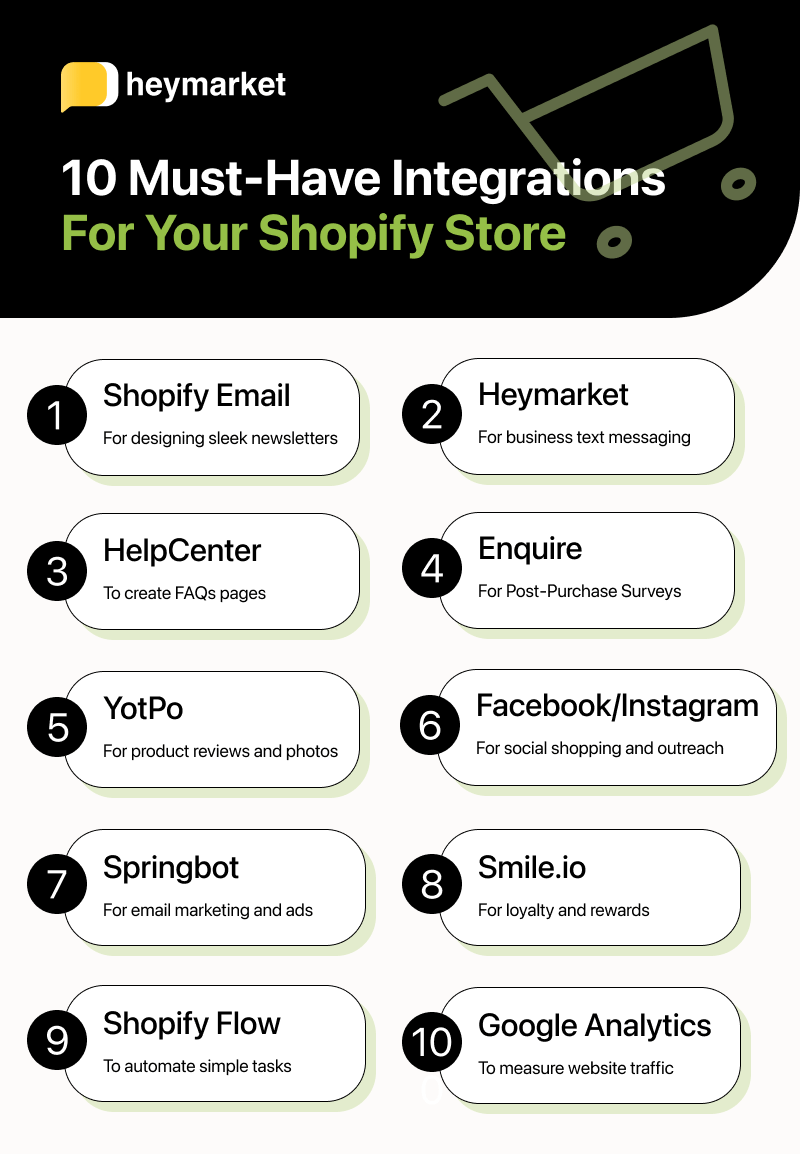10 Shopify Integrations You Should Have for Your Online Store

Shopify makes setting up an online store a straightforward and approachable process. Chances are that if you use Shopify, you found it easy enough to open your website and store. But now that you’re generating site traffic and some sales, you’re ready to take next steps. To improve your customers’ experience while you scale your own operations, you’ll likely need to expand on the tools you use in Shopify.
One of Shopify’s greatest strengths—and one of the reasons it’s expected to dominate eCommerce for years to come—is that it offers both powerful built-in tools and integrations with popular online applications. Created by both Shopify and independent developers, these features and integrations expand Shopify’s capabilities all in the service of taking your online store to the next level.
To help you build up your service and reach, we’ve rounded up 10 Shopify integrations and features that you should adopt.

Shopify Email: Aesthetic Email Newsletters that Boost Sales
Statistics show that repeat customers spend more, and more often, than any other customers. Staying in touch with customers after they’ve placed initial orders helps you build stronger relationships and encourage additional purchases. So which channels should you use to keep connected? You can bet that most of your customers have an email account. That’s a great place to start sending marketing content.
Use Shopify Email to:
- Design sleek newsletters
- Hype up product drops
- Get the word out about business changes
- Track email performance
These aren’t just one-way emails, either. Customers can respond, and those responses will land in your designated business email.
Heymarket: Messaging and Web Chat for Streamlined Chats
Email is a powerful tool for aesthetic marketing campaigns, but it has low open and read rates of 20% and 6%, respectively. When customers want to chat with you right away, messaging and web chat can help you make those immediate connections. Texting has a read rate of 98% and up to a 45% response rate. For web chats, the average wait time between a customer submitting a live chat request and the first agent response is 46 seconds. These tools can expedite your customer service experience.
Heymarket’s Shopify SMS integration empowers you to:
- Add a web chat widget to each of your Shopify store pages
- Start two-way text conversations right from Shopify’s interface
- Send customers automated order updates when their order statuses change, inviting them to respond and spark two-way conversations with your team
- Receive and reply to messages from SMS and popular channels like Facebook Messenger, Instagram Messenger, and WhatsApp in a centralized inbox
- Send personalized SMS marketing campaigns to lists of customers, using custom fields that insert their individual Shopify details
Offering additional Shopify communications options is key to improving customer service. With Heymarket, you can offer more convenient channels than ever before—and manage them easily.
HelpCenter: FAQ Pages That Help Customers Serve Themselves
A lot of customers don’t want to connect with your customer service team first, no matter how speedy your service is. In fact, 69% of customers want to try to resolve queries by themselves before they reach out for help. If you don’t have a form of self service already, prioritize creating an FAQ page.
HelpCenter can help you:
- Create a searchable, aesthetic FAQ section in your online store
- Predict and answer customer questions before they ask them
- Decrease the number of queries your customer service team receives
An FAQ page helps both your customers and your customer service team by providing answers to customers’ simple questions. That way, your team can focus on complex customer queries that arrive through web chat, messaging, and email.
Enquire Post-Purchase Survey: Take Customers’ Temperature After Conversions
Customer service is pivotal to your brand experience; 90% of Americans consider it when deciding whether or not to buy from a company. In order to ensure your customer service experience is up to par—and discover where you can improve—you need to measure it. Surveys can help you get the data you need, especially when conveniently placed on your website.
Use Enquire Post-Purchase Survey to:
- Create seamless, branded surveys
- Place these surveys on key shop pages
- Collect real-time feedback about customer service
Depending on where you place these surveys, you can collect actionable feedback about your customer service, checkout process, site interface, or whatever other aspects of your business’s experience that you’d like to improve.
YotPo: Online Reviews for Website Visitors to See
Online reviews help consumers decide which businesses are trustworthy. That’s why nearly nine out of 10 consumers read online reviews for local businesses in 2020. Incorporating online reviews right on your website saves customers from having to do their research on Google and keeps them in your online shop.
YotPo is an online review integration that:
- Asks customers for reviews with automated emails or texts
- Showcases online reviews and photos on your web pages, Instagram, Facebook, and Google
- Flags negative reviews so your team can respond to them
- Enables you to comment on reviews easily
This tool helps you track your brand’s popularity, engage with reviewers, build lead and customer trust, and boost your online shop’s SEO.
Facebook and Instagram: a Shop Extension That Packs a One-Two Punch
Facebook and Instagram are invaluable channels for outreach. Case in point, 83% of Instagram users discover new products or services on the channel. One of the fastest ways to increase sales is to integrate your Shopify store with Facebook and Instagram. This integration allows customers to browse your products and go all in for a purchase from their favorite social media channels.
The Facebook and Instagram integration empowers you to:
- Create a online shop on your Facebook or Instagram page
- Let customers shop for specific products featured in posts
- Manage all orders right from your Shopify interface
Once you integrate your Shopify store with Instagram, you’ve expanded your reach and digital storefront in one quick move.
Springbot: Upgrade to Dynamic Marketing
When you first started your store, you probably created an initial marketing strategy. Now that your audience has grown, it’s time to take a more dynamic approach. Responding to customer behavior and trends helps you attract their attention, identify the topics or products they’re interested in, and stay relevant.
Springbot helps you:
- Monitor online ad metrics to determine where you can get the most for your money
- Create behavior-based email marketing and organic social media campaigns
- Craft paid advertising campaigns with tools like Google Advertising and Facebook
- Amp up paid efforts with a Campaign Services team
Marketing is key to bringing in more leads and customers. With Springbot, you can figure out how to get the most bang for your buck.
Smile.io: Loyalty Programs That Keep Customers Coming Back
Nearly half of consumers belong to up to three loyalty programs. They’re a popular way for customers to get deals by buying more and more often—and a great way for you to increase your number of repeat customers.
Smile.io works with Shopify to:
- Help you create a points-based reward system
- Show customers how many points each product on your storefront is worth
- Encourage customers to buy with popups that reveal rewards
- Allow customers to decide how many points to use on each transaction
- Automatically contact clients when they have the points needed to claim a discount
Providing an incentive is a great way to keep customers coming back to your store for more shopping. With help from this easily-integratable tool, you can more easily grow your following of loyal customers.
Shopify Flow: Automations Catered to Streamline Shop Management
As you might expect, Shopify has an excellent idea of the challenges Shopify users face. They also know that you’re too busy to keep completing the same simple tasks time and time again. That’s why they offer an app to help you out. (Keep in mind that this tool is available only to Shopify Plus members.)
Among other things, Shopify Flow can automatically:
- Create support tickets when it detects negative reviews for fast customer intervention
- Track negative reviews for measurement and improvement
- Tag customers based on purchasing behavior for personalized marketing
- Organize customers by spend tiers
- Notify you when stock is low, and hide or show products based on stock
By taking over these tasks, Shopify Flow creates a better, more streamlined customer experience—without adding piling more on your team’s workflows. It’s a sustainable way to boost customer satisfaction.
Google Analytics
Data analytics are more important and widespread than ever before. Having data about consumer behavior helps you make more informed decisions about what they’re interested in—and how you can respond. Good analytics are the backbone of effective marketing and sales decisions.
Google Analytics is a tried-and-true tool that:
- Measures website traffic and conversions
- Helps you understand website visitors’ behavior
- Tracks lead and customer interest in marketing, content, and products
Google Analytics makes it easy for you to make decisions about your business. This tool is so standard that it’s right within your Shopify platform. All you need to do is create an account and turn it on from within Shopify’s interface.
Choosing Your Shopify Integrations
Shopify integrations are one of the biggest benefits of the platform. They take an excellent platform and supercharge it, molding it to your needs.
While all of these integrations will help your brand, it can be hard to decide which to choose. Focus on challenges your shop is facing right now. For example, if you’re noticing that leads aren’t converting as much on certain pages, choose an analytics tool like Google Analytics or a marketing tool like Springbot. If you’re getting a lot of repeat questions, use Help Center to create an FAQ page. If your customer engagement is static, use Heymarket to offer customers more opportunities to reach out through channels they like.
No matter which integration you choose, Shopify features and integrations will take your online store to the next level—and beyond.
Want to learn more about Shopify integrations for customer communications? Check out our blog.




